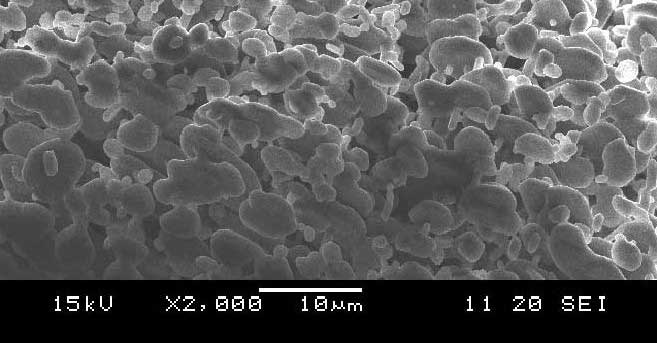
Ceratek will help all your material concerns, starting at material selection, for your ceramic needs.Our experienced material expert formulate and test new materials to help design engineers overcome technological barriers for their product applications.We encourage you to discuss your project with us early to avoid difficult problems later. We will specify the benefits of each material and discuss various processing techniques used to manufacture your product.

ALUMINIUM OXIDE (AL2O3)
Normally Alumina ceramic has from 75% to 99% Al2O3 content.These aluminum oxide ceramics have a variety of properties:high mechanical strength and hardness,hig wear resistance and corrosion resistance,high thermalconductivity,high insulation.Almost all field of application use this kind of material because of its many properties and combination properties with other material and its good price-performance ratio.
Please find the alumina ceramic properities ![]() alumina ceramic properities(PDF file).pdf
alumina ceramic properities(PDF file).pdf
ZIRCONIUM OXIDE (ZrO2)
Zirconia occurs in monoclinic, tetragonal and cubic crystal modifications.
Depending on their specific crystalline structure, zirconium oxides has many better properties:
high flexura and tensile strength,high fracture toughness,good corrosion and wear resistance,low thermal conductivity
Zirconia Toughened Alumina – ZTA
Zirconia Toughened Alumina (ZTA) ceramic show considerable improvement in strength and toughness over alumina ceramics.Typical content is from 10% to 20% zirconia. When a crack grows through the ceramic,the zirconia particles rystal structure in the region of the crack changes from the metastable tetragonal phase to the stable monoclinic phase.The change increases the volume of the particles by about 3-4% and produces compressive stresses in the alumina matrix. These stresses in turn close the crack and act as an energy barrier to further crack growth. The addition of zirconia to the alumina matrix increases fracture toughness by two times and can be improved by as high as four times, while strength is more than doubled.ZTA components are more expensive than those in alpha alumina. However, they have cost effective solutions for demanding environments because of increased component life and performance
Please find the Zirconia ceramic properities ![]() Zirconia ceramic properities(PDF file).pdf
Zirconia ceramic properities(PDF file).pdf
STEATITE
Their basis of natural raw materials (major component: soapstone, additives: clay and flux) form the group of magnesium silicates. The type of flux influences the electrical characteristics and leads to the following differentiation of low-frequency, as well as special steatite with "low loss factor"- sometimes kwon as high-frequency steatite.The characteristics are such as high mechanical strength,dielectrical properties,thermal insulation,good resistance for temperature sudden changes,enduring heat expansion,corrosion resistance.Because of these propertis,they are widely used in electrical and thermal.
Please find the steatite ceramic properities ![]() Steatite Ceramic Properities(PDF file).pdf
Steatite Ceramic Properities(PDF file).pdf
CORDIERITE
The main chemical ingredient of cordierite is 2MgO 2Al2O3 5SiO2,main material is steatite、clay、alumina、feldspar,etc.They have the following additional characteristics:low thermal expansion coefficient,high resistance to thermal shock.Generally used in heat engineering and electrical engineering.
Please find the Cordierite Ceramic Properities ![]() Cordierite Ceramic Properities(PDF file).pdf
Cordierite Ceramic Properities(PDF file).pdf
Silicon Carbide
They are very hard and have a high thermal conductivity. This has led to silicon carbide being used in bearing and rotary seal applications where the increased hardness and conductivity improves seal and bearing performance.This materials has good erosion and abrasive resistance, these properties can be used in a variety of applications such as spray nozzles, shot blast nozzles and cyclone components.
SINTERED SILICION CARBIDE
They are made from SC finest powder and sinter additives, sintered at 2000 to 2200 °C in a controlled atmosphere. Its outstanding features are very high strength and extremly high resistance to corrosion,the typical high thermal shock resistance,thermal conductivity,wear resistance and a hardness similar to a diamond.
Please find the sintered silicon carbide properities
![]() Sintered Silicon Carbide Ceramic(PDF file).pdf
Sintered Silicon Carbide Ceramic(PDF file).pdf
REACTION BONDED SILICON CARBIDE
The material is 85 - 94% of SC and 15 - 16% of metallic silicon. There is no shrinkage during the sintering process because of the composite manufacturing process. This is why extraordinary large components with exact dimensions can be manufactured. The application temperature is limited to approx. 1380 °C due to the share of metallic silicon.
The characteristics:high strength and corrosion resistance,combined with excellent thermal shock resistance and resistance to wear.
Please find the Reaction bonded silicon carbide properities
![]() REACTION BONDED SILICON CARBIDE Ceramic Properities(PDF file).pdf
REACTION BONDED SILICON CARBIDE Ceramic Properities(PDF file).pdf